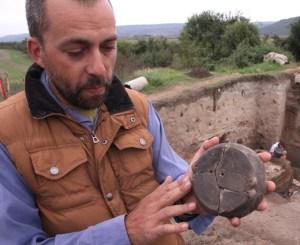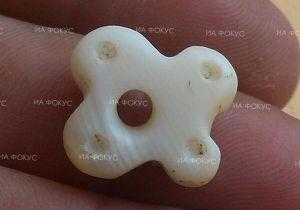Ivan Dikov
Source - http://archaeologyinbulgaria.com/2016/01/18/archaeologists-find-wooden-wall-four-leaf-clover-amulet-in-prehistoric-settlement-mound-in-bulgarias-petko-karavelovo/
 Archaeologist Alexander Chohadzhiev shows the lid of a prehistoric vessel found in the Chalcolithic settlement mound near Bulgaria’s Petko Karavelovo, which was repaired in an interesting way back in the Copper Age. Photo: Borba daily
Archaeologist Alexander Chohadzhiev shows the lid of a prehistoric vessel found in the Chalcolithic settlement mound near Bulgaria’s Petko Karavelovo, which was repaired in an interesting way back in the Copper Age. Photo: Borba daily
7,000-year-old archaeological structures and artifacts from theChalcolithic (Aeneolithic, Copper Age), including a wooden wall, a loom, and a shell amulet have beendiscovered during the 2015 excavations of the prehistoric settlement mound in Bulgaria’s Petko Karavelovo.
The prehistoric mound in town of Petko Karavelovo, Polski Trambesh Municipality, Veliko Tarnovo District in Central North Bulgaria has been excavated by the team of archaeologist Alexander Chohadzhiev from the Veliko Tarnovo Regional Museum of History.
The 2015 digs have been funded with BGN 7,000 (app. EUR 3,500) in government funding from the Bulgarian Ministry of Culture, and have been carried out with the participation of archaeology students from Veliko Tarnovo University “St. Cyril and St. Methodius" and New Bulgarian University in Sofia.
The most interesting discovery from the 2015 excavations of the prehistoric settlement mound near Petko Karavelovo has been the remains of a wooden wall from a Chalcolithic home, with preserved girders (support beams) and paneling, reports local daily Borba.
“The preserved wooden remains are 7,000 years old. But apart from this really impressive age, what has been more interesting for me is the fact that we have come across a structure that we had not studied earlier," lead archaeologist Chohadzhiev is quoted as saying.
“We have unearthed rectangular beams stuck into the ground which were then plastered with clay, and after that were paneled with wooden boards. Until now, we had seen structures made with wooden poles reminding apicket fence, but we had never had the chance to study homes built this way," he explains.
Both the Chalcolithic girders, and the paneling beams found by the archaeologists are well preserved.
“The prehistoric people would build their homes on top of their ancestors’ homes. They would adhere to the original layout, and would level up the remains from the older houses not by removing [the material] the way we do it today but by piling up [on it]. They would build clearly aware of the fact that they were building a settlement mound. Thus, for a period of 200 years, for example, during which four generations lived, the settlement moundgrew in height by 3 meters," elaborates the archaeologist.
His team discovered the wooden remains in a Chalcolithic homethat was destroyed by a flood, not by a fire.
Chohadzhiev notes that the water destroyed the clay while preserving the wood, whereas in the event of a fire, it would have been the other way around.
The prehistoric home’s entrance was 1.4 meters wide; in front of the house, there was a roofed platform where thearchaeologists found a kiln. A second kiln has been found inside the house.
The home had three different sections. It was about 7 meters wide and 11 meters long.
“This shouldn’t surprise us because in previous years, we have had buildings with an area of up to 150 square meters… This building had several floors. The house saw several major repairs," he says.
The Chalcolithic home explored by Chohadzhiev’s team in the Petko Karavelovo settlement mound in 2015 is the site’s earliest home known to date. It belongs to the earliest layer of the prehistoric settlement.
It is noted that other prehistoric settlements in the Veliko Tarnovo region found near the towns of Kachitsa andHotnitsa feature similar archaeological layers but their exploration is hindered by the moisture on the respective sites.
Another intriguing find from the 2015 digs at Petko Karavelovo is a set of 22 clay weights from a horizontal loomwith a combined total width of 94 cm.
“Back then the unit of measurement was the cubit. The loom was about two cubits, i.e. it was wide as much as the cloth that was woven. Even today this is the width of rugs. What is more, until recently such looms were used in Scandinavia, we know them very well from theVikings," Chohadzhiev says, adding that the loom, which dates back to the 5th millennium BC, is a valuable discovery.
However, it is an amulet made from the shell of the Spondylus mollusk, a species found in the Mediterranean, which has been discovered as “the top find" from the prehistoric settlement mound in Bulgaria’s Petko Karavelovo. The shell amulet is shaped as a four-leaf clover.
“Actually, depending on the angle from which you are looking at it, the amulet also resembles a cross," says the archaeologist.
A total of 11 beads which were also made from the shell of the Spondylus mollusk have also been discovered. Thebeads are white and probably were part of a bracelet.
 This “four-leaf clover” amulet made of Spondylus mollusk shell has been found in the Chalcolithic settlement mound in Bulgaria’s Petko Karavelovo. Photos: Focus News Agency
This “four-leaf clover” amulet made of Spondylus mollusk shell has been found in the Chalcolithic settlement mound in Bulgaria’s Petko Karavelovo. Photos: Focus News Agency
Chohadzhiev explains that during the Copper Age, one of the trade routes for the distribution of the Mediterranean mollusk shells probably passed by the settlement mound near Petko Karavelovo which is located close to the Yantra River.
In his words, the four-leaf clover amulet is very interesting because similar prehistoric artifacts have been found but those were made of marble, not mollusk shell. The Spondylus shells may have been extremely valuable back at the time when copper mining was just emerging, and gold probably had not been discovered yet.
The archaeologist has also pointed to a vessel lid which seems to have been repaired back in prehistoric times based on traces of amber used to glue it back together when it was damaged. The prehistoric people even made holes in it in order to put a string through them so they can bring two sides of the cracked lid back together, and apply the glue.
“Apparently, it was very valuable for them even though in terms of craftsmanship, it is nothing special," he concludes.
Chohadzhiev’s team has discovered more than 250 artifacts during the 2015 excavations of the Chalcolithic settlement mound in Petko Karavelovo.
The prehistoric settlement mound was first excavated back in 2003 with rescue probes because it had been targeted by treasure hunters.
The regular annual archaeological excavations began in 2009, and the archaeologists have already explored all of its layers.
The Petko Karavelovo settlement mound dates back to the beginning of the Chalcolithic (Aeneolithic, Copper Age), ca. 4900-4800 BC. It is about 500-600 older than another Chalcolithic site nearby, the prehistoric mound in Bulgaria’s Hotnitsa.